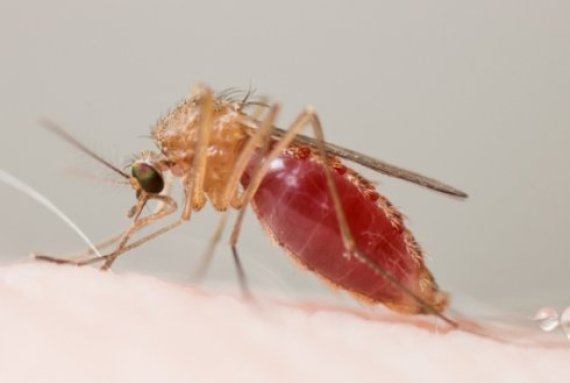<photo: de Culex pipiens>
The West Nile virus, originating from Africa, is emerging from the south of Europe, but has not reached the Netherlands yet. Most people do not become ill from the virus, but the sick and the elderly can get the flu and for a small percentage the illness can be life threatening. In 1999 the West Nile virus suddenly appeared in America, which caused about 1800 casualties. Until now only a few hundred people have died due to this illness in Europe. The PhD candidate Vogels wants to know what the risks are for Northern Europe.
The virus is spread by the common house mosquito (Culex pipiens) that regularly keeps us awake at night. It has two biotypes, pipiens and molestus, that look the same but express different behaviour. Pipiens has a preference for birds as a host and overwinters aboveground in the Netherlands. Molestus bites mammals, including humans, and preferably spends the winter underground. In the Netherlands for example it stays in the metro tunnels of Amsterdam and in the underground baggage systems of Schiphol.
Although both biotypes of Culex pipiensbite us, they do not transmit the virus (yet) in The Netherlands. In the first place this is because there are no infected birds in the Netherlands, secondly because it was previously thought that the two mosquito types live separately and do not hybridize. But Vogels has now shown that both biotypes are found in our houses and indeed they crossbreed. She examined mosquitoes from traps outside and also last year she asked Dutch citizensto send mosquitoes, that were killed inside their house, to Wageningen. From the analyses it was found that 6 to 15 percent of these mosquitoes were hybrids between the pipiens andthe molestus. The hybrids are potentially dangerous, because they could possibly bridge the virus directly from birds to humans. Due to her research, the risk assessment needs to be tightened for the West Nile virus.
Luckily the virus does not occur in the Netherlands yet. It was however found in birds in for example Greece, France and Romania, but not in birds in the Netherlands. There must be some sort of natural barrier, Vogels thinks, who expects that the low temperatures in the North of Europe are an important barrier. She is now going to study this further. In a heavily secured lab she will infect mosquitoes with the West Nile virus at different temperatures and then test if the virus appears in saliva of the mosquitoes, because only then there is a chance of transmission.
‘If the West Nile virus unexpectedly arrives in the Netherlands, you want to be prepared and you want to know: which mosquitoes are found here, and can they transmit the disease? Furthermore, it is important to gain fundamental knowledge about the occurrence of potential vectors.’
Previous articles
Our mosquito can transmit virulent virus
Mosquito radar gets permanent successor

